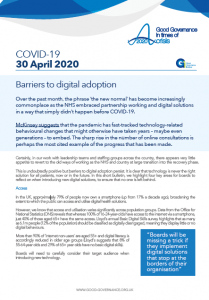Barriers to digital adoption
30 April 2020

Over the past month, the phrase ‘the new normal’ has become increasingly commonplace as the NHS embraced partnership working and digital solutions in a way that simply didn’t happen before COVID-19.
McKinsey suggests that the pandemic has fast-tracked technology-related behavioural changes that might otherwise have taken years – maybe even generations – to embed. The sharp rise in the number of online consultations is perhaps the most cited example of the progress that has been made.
Certainly, in our work with leadership teams and staffing groups across the country, there appears very little appetite to revert to the old ways of working as the NHS and country at large transition into the recovery phase.
This is undoubtedly positive but barriers to digital adoption persist. It is clear that technology is never the right solution for all patients, now or in the future. In this short bulletin, we highlight four key areas for boards to reflect on when introducing new digital solutions, to ensure that no one is left behind.
Access
In the UK, approximately 79% of people now own a smartphone (up from 17% a decade ago), broadening the extent to which the public can access and utilise digital health solutions.
However, we know that access and utilisation varies significantly across population groups. Data from the Office for National Statistics (ONS) reveals that whereas 100% of 16-24-year-olds have access to the internet via a smartphone, just 40% of those aged 65+ have the same access. Lloyd’s annual Basic Digital Skills survey highlights that as many as 6.1m people (12% of the population) should be classified as digitally disengaged, meaning they display little or no digital behaviours.
More than 90% of ‘internet non-users’ are aged 55+ and digital literacy is accordingly reduced in older age groups (Lloyd’s suggests that 8% of 55-64-year olds and 29% of 65+ year olds have no basic digital skills).
Boards will need to carefully consider their target audience when introducing new technology.
Digital skills in the workforce
The Lloyd’s survey also indicates that more than half of UK employees (53%) lack the digital skills needed for work.
Historically, a major barrier to digital adoption within the NHS has been staff knowledge and attitudes towards technology. A recent CQC report suggested this was typically a consequence of poor previous experiences of technology, as well as the perceived complexity of adopting digital solutions. Effective engagement of staff should also be considered a key factor, especially in the design and onboarding phases.
Boards need to work hard to socialise new innovations with staff and ensure that they are offering appropriate training and development opportunities.
Information governance
The degree to which personal information is handled discretely and effectively will have a bearing on how much users trust any digital solution.
Organisations in the UK now have to comply with the General Data Protection Regulation (GDPR), which requires explicit consent from users before any data is collected.
However, this does not mean that all organisations operating in the UK are now automatically good custodians of personal data. A 2018 survey of data protection professionals revealed that 56% of respondents felt that their organisations were either far from compliance or would never comply with GDPR.
Before the introduction of GDPR, a 2015 study demonstrated that of 79 apps endorsed on the NHS Apps website, 38 had privacy policies that failed to specify what information was being sent over the internet, 73 lacked encryption for stored data, and 23 were found to be transmitting unencrypted identifiable information.
While attitudes to privacy and data protection vary by age groups, boards will need to be mindful of these concerns when utilising digital health solutions.
Interoperability
The ability of computer systems or software to exchange and make use of information and the extent to which any digital solution is able to be integrated with existing GP and hospital systems should be considered a key enabler for its promotion and adoption.
Interoperability is increasingly recognised as vital to delivering the vision outlined in the NHS Long Term Plan and other recent policy guidance. This is reflected in the 2018 NHS IT Leadership Survey, in which 82% of respondents cited ‘interoperability that enabled systems and staff to share information on patients’ as their highest priority (25).
Boards will be missing a trick if they implement digital solutions that stop at the borders of their organisation.
We are keen to hear your views. If this briefing prompts any questions or comments, please call us on 07732 681120 or email us at advice@good-governance.org.uk. We will aim to respond within 24 hours.

